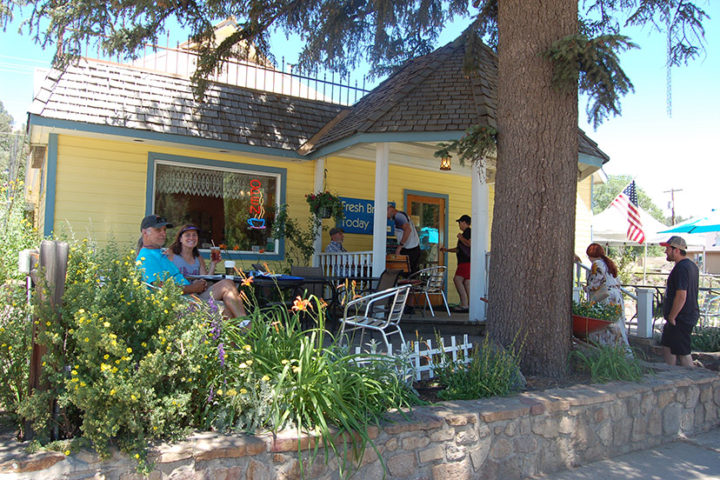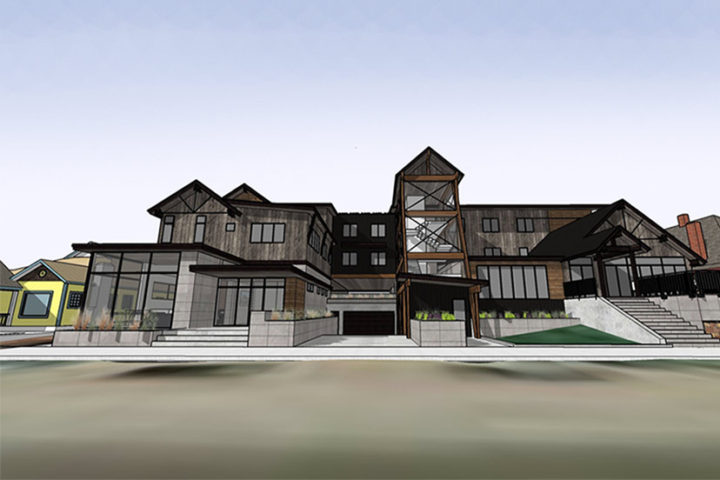PHOTO: The vacant lots where Dirty Rose LLC is proposing a 43,800-square-foot mixed use building.
As discussed in Part Two, yesterday, the Pagosa Springs Planning Commission, on July 12, seriously considered the suggestions from the Town Planning Department staff and from the members of the audience. The Town staff had recommended, for example, several conditions for approval of the Pagosa Street Development ‘sketch plan’… including condition number 6:
6) Design modifications that demonstrate substantial compliance with the intent MU-TC, [East Village] Overlay District, and Downtown Master Plan with respect to pedestrian-friendly environment, four-sided design, reduced perceived mass and scale, as outlined in 6.7.3.A.5, 6.7.3.B.1 and 4, and 6.7.7.C;
The audience had been unanimous in its opinion that the (massive?) three-story, 43,800 square foot building does not fit the character of the East Village neighborhood, and the Planning Commission agreed with that assessment.
The property owners (Dirty Rose LLC and Alley House LLC) and their architects (Reynolds Ash & Associates) were directed at the July 12 Planning Commission hearing, to bring back a less massive design — and also something that was more ‘pedestrian friendly’ and with more consistent ‘four-sided’ design on the sides that face the neighboring properties (sides and rear).
The approval of the ‘Sketch Plan’ was continued, by a four-to-one vote, to a future meeting on August 9.
No doubt the two architects — Brad Ash and Lauren Davis — found the decision disappointing, after many hours of creative work designing a proposed 43,800-square-foot building for the three vacant lots just west of the Alley House Grill, and just east of Pagosa Baking Company.

Following the decision, Commission chair Chris Pitcher continued with the agenda, which specified an opportunity for general public comments.
Architect Brad Ash took the microphone in hand.
“A couple of things, and just when we’re talking about projects, and vacant property, not to make assumptions how they are going to build out, and how they might potentially affect town developments.
“And talking about how developments may or may not [provide parking], relative to another development. That is not the developer’s issue, as of tonight.
“The other thing. I’m a resident here for 41 years, for my entire life. I went away and came back. I think if we did a count, I think it’s nine or ten buildings that have been torn down or burnt down in Pagosa Springs. And if we’re blind to Pagosa Springs growing, and the people who are watching what is going on in town, I think you need to consider that Pagosa is discovered. We all know that it is.
“We all want it to grow right. We all want it to be the right way, but at the same time, it’s not ignoring what’s going on outside of Archuleta County. There’s huge growth. There’s big houses. There’s people with money. Expectations are rising, as they come to our community.”
Mr. Ash is, of course, correct. As wealthier people move into Archuleta County — and let’s face it, with home prices and building costs where they are currently, only wealthier people can afford to move here — the “expectations” are changing, to suit those wealthier people.
Mr. Ash continued:
“So I’m just wanting to put that out there, these [kinds of projects] are going to be more in front of you. And considering what it takes to develop projects anymore, and for projects to even ‘pencil’… we’re not Durango, we’re not Telluride, we’re not some of these places where you’re getting ludicrous prices per square foot. This is a very difficult town to develop in…”
Mr. Ash is presumably referring to commercial rental properties, which have never quite recovered from the effects of the Great Recession in Pagosa, from 2008 through 2012. True, we’re not Durango or Telluride. Not yet.
Residential properties here, meanwhile, are reaping rather fabulous rents and sales prices — twice what were being garnered in 2012.
Mr. Ash continued addressing the Planning Commission:
“As these developers bring these projects in front of you, I know ‘budgets’ are not part of your considerations, but I think it’s to be considerate of what’s being proposed. I’m not necessarily saying that wasn’t done tonight, but be prepared for it, because there’s more coming.”
From my perspective, and perhaps from Mr. Ash’s perspective as well, the Town’s LUDC exists to prevent, or mitigate, the destruction of our town neighborhoods as we currently enjoy them. I don’t agree with everything written in the LUDC, however, and obviously Mr. Ash feels the same way, although for different reasons perhaps.
The Planning Commission and the Planning Department, meanwhile, are charged with making decisions consistent with the LUDC. Often, the LUDC regulations conflict with what developers believe will ‘pencil’.
The question then becomes, do we choose to preserve the character of our neighborhoods, or do we make development as convenient as possible for developers? It’s a thorny situation.
Some folks really want to see Pagosa explode with new projects, and become a very different place, to accommodate the “people with money” who, Mr. Ash claims, are destined to move into our town.
Some of us, on the other hand, really like the town we found when we moved here, or in some cases, the town we grew up in. That town has already vanished, to a large degree.
The discussion on Tuesday evening, between the Planning Commission and the East Village neighbors and the developers’ architects, was a great example of honoring what already exists in Pagosa’s downtown, with the understanding that, yes, we can change. We can grow slowly, and carefully. We don’t have to embrace explosive growth.
The Daily Post has shared many articles from the group known as ‘Strong Towns’ — a national organization that promotes sensible growth, and especially, incremental growth. And especially, the type of growth that helps sustain ‘community’.
We shared a Strong Towns article last month, written by the organization’s founder, Charles Marohn, in which he discusses ‘incremental change’ in neighborhoods.
He writes:
At Strong Towns, we believe that housing markets need to be sensitive to neighborhoods and the needs of people living within them, rather than macroeconomic policy goals and the institutions that dominate them. Such a bottom-up orientation requires strong local leadership.
To that end, we have come to rely on a simple truth: No neighborhood should experience radical change, but no neighborhood can be exempt from change. It is not healthy for neighborhoods to radically transform, uprooting people and distorting established price relationships. It is equally unhealthy for neighborhoods to be locked in amber, artificially stagnating despite market demands or the needs of people within the community.
(You can read the full article, here.)
We don’t want to simply accommodate developers, willy nilly, here in Pagosa. A developer’s primary intention, very often, is to make a profit. To become wealthier.
The primary intention, of many of us who live here, is to have an authentic, functional community.
I believe those are two different sets of values.
Can our municipal government find a happy medium… by embracing ‘incrementalism’?


